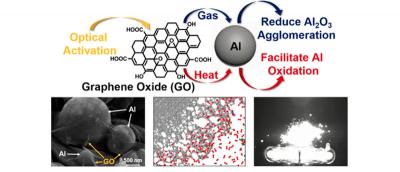Researchers from the U.S. Army, in collaboration with RDECOM Research Laboratory, the Army's corporate research laboratory (ARL), Stanford University, MIT, University of Southern California and Argonne National Laboratory, have discovered a way to get more energy out of energetic materials containing aluminum, common in battlefield systems, by igniting aluminum micron powders coated with graphene oxide. This research could lead to enhanced energetic performance of metal powders as propellant/explosive ingredients in Army's munitions.

This discovery makes use of graphene oxide as an effective light-weight additive for practical energetic applications using micron-size aluminum powders (µAl), i.e., aluminum particles one millionth of a meter in diameter.
Nanometer-sized Al powders can be ignited more easily by a wide-area optical flash lamp to release heat at a much faster rate than can be achieved using conventional single-point methods such as hotwire ignition. Unfortunately, nanometer-sized Al powders are very costly.
The team demonstrated the value of µAl/GO composites as potential propellant/explosive ingredients. This research demonstrated that GO can enable the efficient ignition of µAl via an optical flash lamp, releasing more energy at a faster rate - thus significantly improving the energetic performance of µAl beyond that of the more expensive nanometer-sized Al powder. The team also discovered that the ignition and combustion of µAl powders can be controlled by varying the GO content to achieve the desired energy output.
In addition to demonstrating enhanced combustion effects from optical flash lamp heating of the µAl/GO composites by the Stanford group, Dr. Gottfried, a physical scientist at ARL, demonstrated that the GO increased the amount of µAl reacting on the microsecond timescale, i.e., one millionth of a second - a regime analogous to the release of explosive energy during a detonation event. Upon initiation of the µAl/GO composite with a pulsed laser using a technique called laser-induced air shock from energetic materials (LASEM), the exothermic reactions of the µAl/GO accelerated the resulting laser-induced shock velocity beyond that of pure µAl or pure GO. According to Gottfried, "the µAl/GO composite thus has the potential to increase the explosive power of military formulations, in addition to enhancing the combustion or blast effects." As a result, this discovery could be used to improve the range and/or lethality of existing weapons systems.